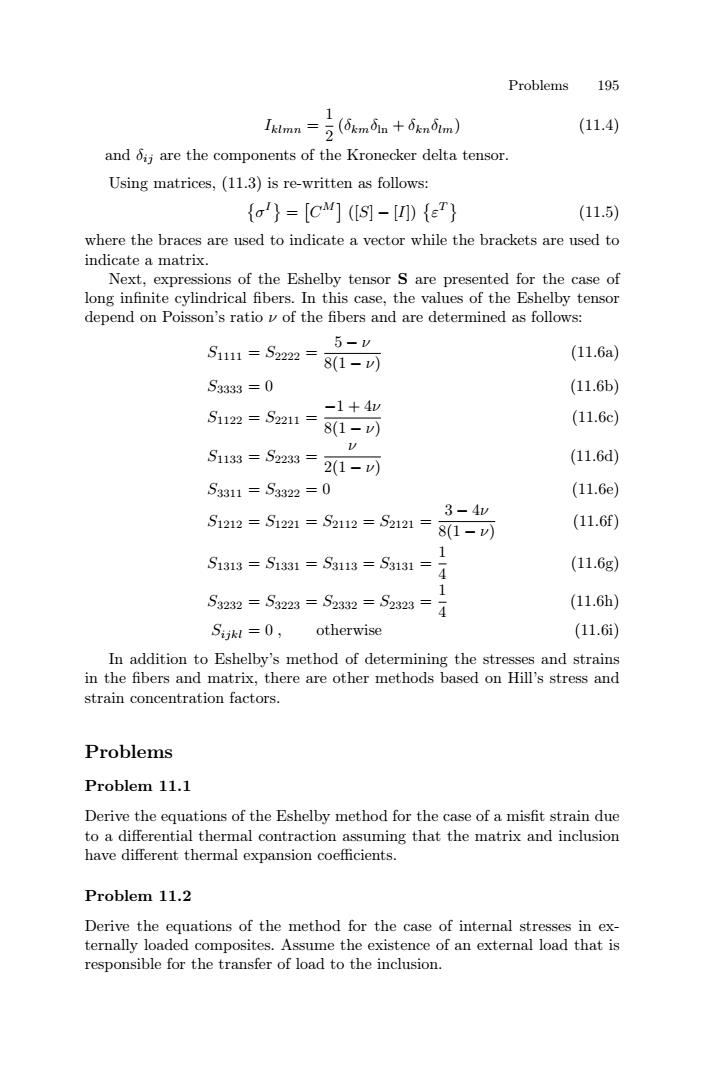正在加载图片...

Problems 195 1 Ikmn=(6kmomn +6knoim) (11.4) and 6ii are the components of the Kronecker delta tensor. Using matrices,(11.3)is re-written as follows: {a}=[C](S-){e} (11.5) where the braces are used to indicate a vector while the brackets are used to indicate a matrix. Next,expressions of the Eshelby tensor S are presented for the case of long infinite cylindrical fibers.In this case,the values of the Eshelby tensor depend on Poisson's ratio v of the fibers and are determined as follows: 5-v S1111=S2222= (11.6a) 8(1-w) S3333=0 (11.6b) -1+4w S1122=S2211= (11.6c) 8(1-v) 51133=52233= 2(1-w (11.6d) S3311=S3322=0 (11.6e) 3-4v S1212=S121=S212=S2121=81-D (11.6f) 1 S1313=S1331=S3113=53131=4 (11.6g) 1 53232=53223=S2332=52323=4 (11.6h) Sijk=0, otherwise (11.6i) In addition to Eshelby's method of determining the stresses and strains in the fibers and matrix,there are other methods based on Hill's stress and strain concentration factors. Problems Problem 11.1 Derive the equations of the Eshelby method for the case of a misfit strain due to a differential thermal contraction assuming that the matrix and inclusion have different thermal expansion coefficients. Problem 11.2 Derive the equations of the method for the case of internal stresses in ex- ternally loaded composites.Assume the existence of an external load that is responsible for the transfer of load to the inclusion.Problems 195 Iklmn = 1 2 (δkmδln + δknδlm) (11.4) and δij are the components of the Kronecker delta tensor. Using matrices, (11.3) is re-written as follows: $ σI% = ! CM" ([S] − [I]) $ εT % (11.5) where the braces are used to indicate a vector while the brackets are used to indicate a matrix. Next, expressions of the Eshelby tensor S are presented for the case of long infinite cylindrical fibers. In this case, the values of the Eshelby tensor depend on Poisson’s ratio ν of the fibers and are determined as follows: S1111 = S2222 = 5 − ν 8(1 − ν) (11.6a) S3333 = 0 (11.6b) S1122 = S2211 = −1+4ν 8(1 − ν) (11.6c) S1133 = S2233 = ν 2(1 − ν) (11.6d) S3311 = S3322 = 0 (11.6e) S1212 = S1221 = S2112 = S2121 = 3 − 4ν 8(1 − ν) (11.6f) S1313 = S1331 = S3113 = S3131 = 1 4 (11.6g) S3232 = S3223 = S2332 = S2323 = 1 4 (11.6h) Sijkl = 0 , otherwise (11.6i) In addition to Eshelby’s method of determining the stresses and strains in the fibers and matrix, there are other methods based on Hill’s stress and strain concentration factors. Problems Problem 11.1 Derive the equations of the Eshelby method for the case of a misfit strain due to a differential thermal contraction assuming that the matrix and inclusion have different thermal expansion coefficients. Problem 11.2 Derive the equations of the method for the case of internal stresses in externally loaded composites. Assume the existence of an external load that is responsible for the transfer of load to the inclusion